Finding the perfect way to bring your bikes along on travel trailer adventures can be challenging. Many RVers understand the struggle of wanting to explore biking trails at their destination, but worrying about the safety and security of their bikes during transit. After three years of rigorous testing, including a journey to Alaska and back, I’ve gained valuable insights into what makes a Travel Trailer Bike Rack reliable and effective. This review focuses on the Swagman RV-Approved Bike Rack, highlighting its durability and key features, alongside essential considerations for choosing the best travel trailer bike rack for your needs.
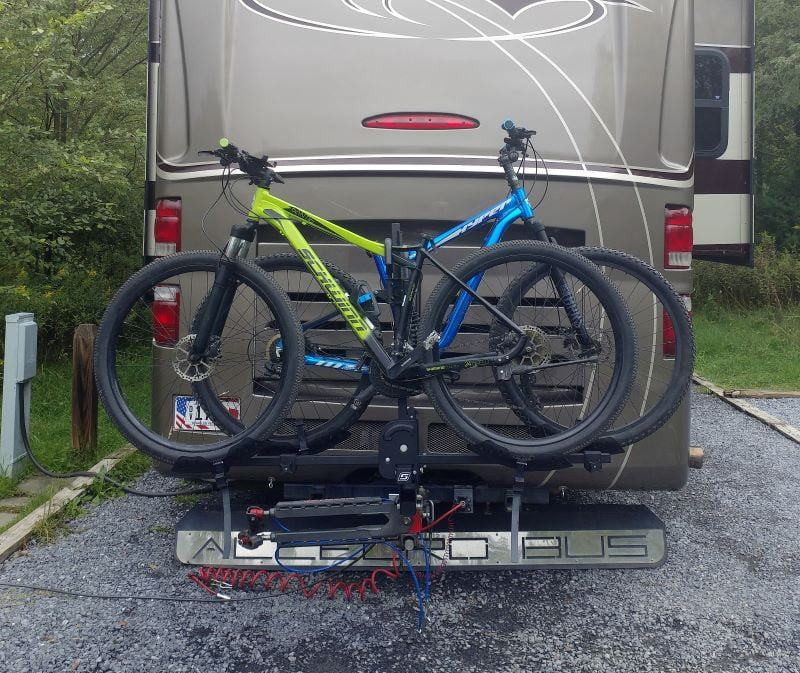 Here I have attached the bikes to the bicycle rack but have not yet installed the covers on the bikes or finished installing the red electrical cable which is currently laying on the ground.
Here I have attached the bikes to the bicycle rack but have not yet installed the covers on the bikes or finished installing the red electrical cable which is currently laying on the ground.
Why a Robust Bike Rack is Essential for Travel Trailers
Unlike car bike racks, travel trailer bike racks face unique challenges due to the motion and structure of RVs. I’ve witnessed firsthand the damage caused by inadequate bike racks on RVs, particularly on rough roads like those encountered on the way to Alaska. Stories of bike rack failures are unfortunately common among RVers. This is why upgrading to a robust, RV-approved bike rack became a priority for me in 2021.
My experience with the Swagman RV-Approved Bike Rack over the past three years has been overwhelmingly positive. It consistently performs as intended, offering peace of mind on every journey. This reliability is crucial, as bike rack failure on a travel trailer can lead to significant damage, not just to the bikes but potentially to the tow vehicle as well.
Three Years with the Swagman RV-Approved Bike Rack: A Long-Term Review
My initial positive assessment of the Swagman RV-Approved Bike Rack has been completely validated by three years of use. This rack has proven to be exceptionally robust, enduring thousands of miles on the back of my travel trailer, including a demanding round trip to Alaska. Despite occasional transfers to our car, the rack shows minimal wear and tear and functions flawlessly.
For RV owners, finding trouble-free accessories is a major win. The Swagman bike rack stands out as one of those items that simply works, eliminating worries about bike security during travel. This consistent performance is a testament to its design and construction.
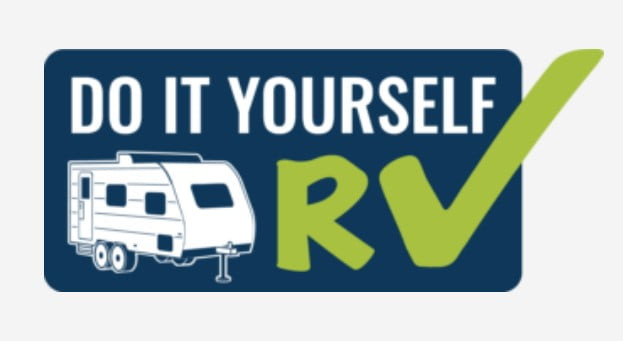 DIY RV LOGO
DIY RV LOGO
Understanding RV Bike Rack Strength and Construction
One of the most compelling features of the Swagman RV-Approved Bike Rack is its sheer strength. To demonstrate this, I even stood on the rack, supporting my full weight – significantly more than the combined weight of two e-bikes.
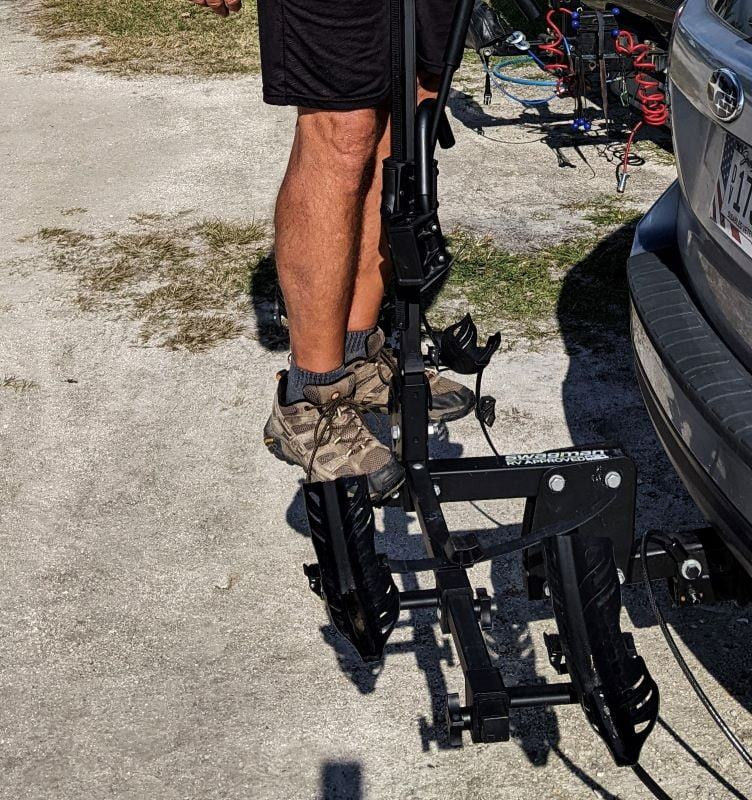 I didn
I didn
This test wasn’t just for show; it underscores the rack’s ability to handle substantial loads. However, it’s important to remember that the dynamic forces acting on a travel trailer bike rack while driving are much greater than static weight. The constant motion, vibrations, and swaying of the RV amplify stress on the rack. This is why a standard car bike rack is often inadequate for travel trailers.
I’ve seen firsthand the consequences of using weaker racks. A friend’s experience with a bent dual hitch adapter after an Alaska trip vividly illustrates the forces at play. The weight of the bikes and rack alone caused significant damage to a solid steel component.
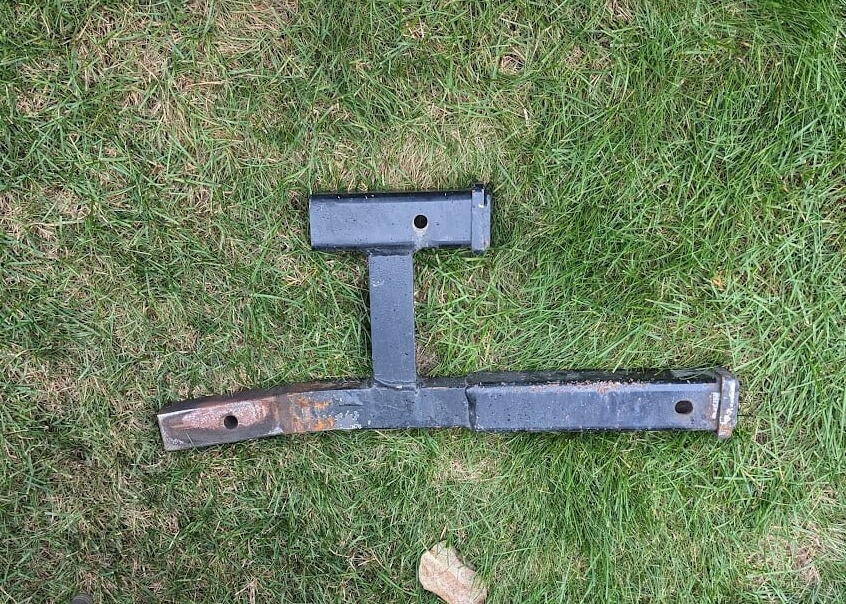 A bent dual hitch adapter after a trip to Alaska.
A bent dual hitch adapter after a trip to Alaska.
This incident highlights a critical point: travel trailer bumpers are not designed to support bike racks. Attaching a bike rack to a trailer bumper is a recipe for disaster, likely leading to bumper failure and potential loss of your bikes.
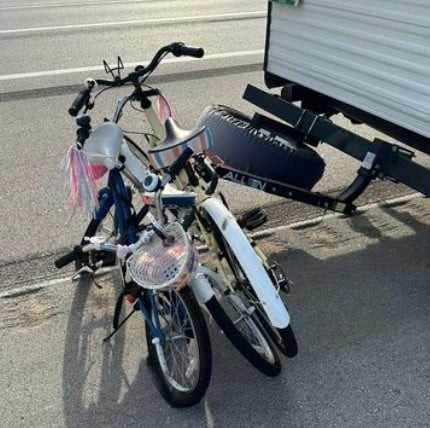 Trailer bumper failure.
Trailer bumper failure.
The Swagman RV-Approved Bike Rack addresses these concerns with its robust, all-steel construction (excluding the wheel straps). This no-frills, non-folding design prioritizes strength and minimizes potential failure points. While folding racks offer convenience, they introduce hinges, which can become weak points under the stress of RV travel.
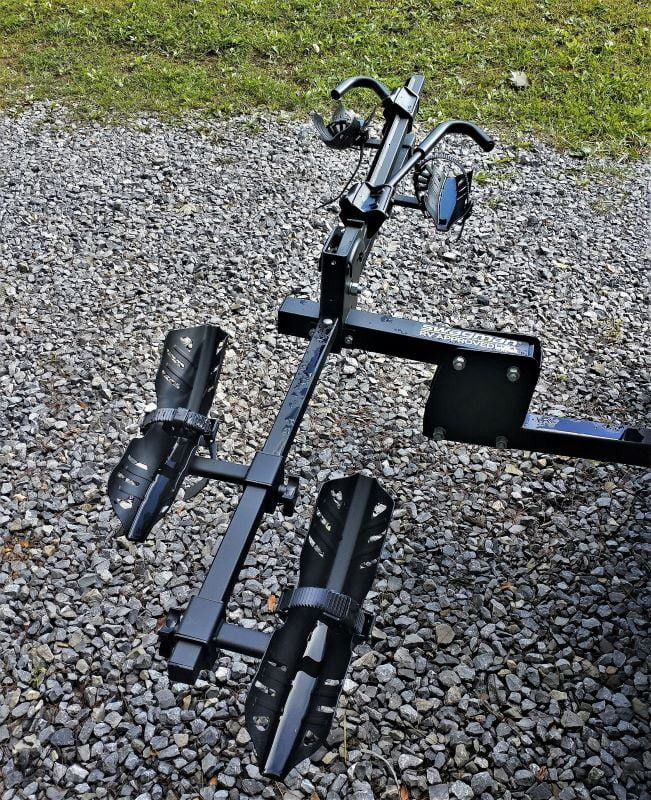 Every part of the bike rack that you see in this picture is made of steel except the wheel straps.
Every part of the bike rack that you see in this picture is made of steel except the wheel straps.
Optimizing Bike Rack Placement on Your Travel Trailer
My preferred setup positions the bikes between the travel trailer and the tow vehicle. This location offers some protection and keeps the bikes relatively out of the way. While they could be transported uncovered, I prefer using bike covers for added protection from the elements and road debris.
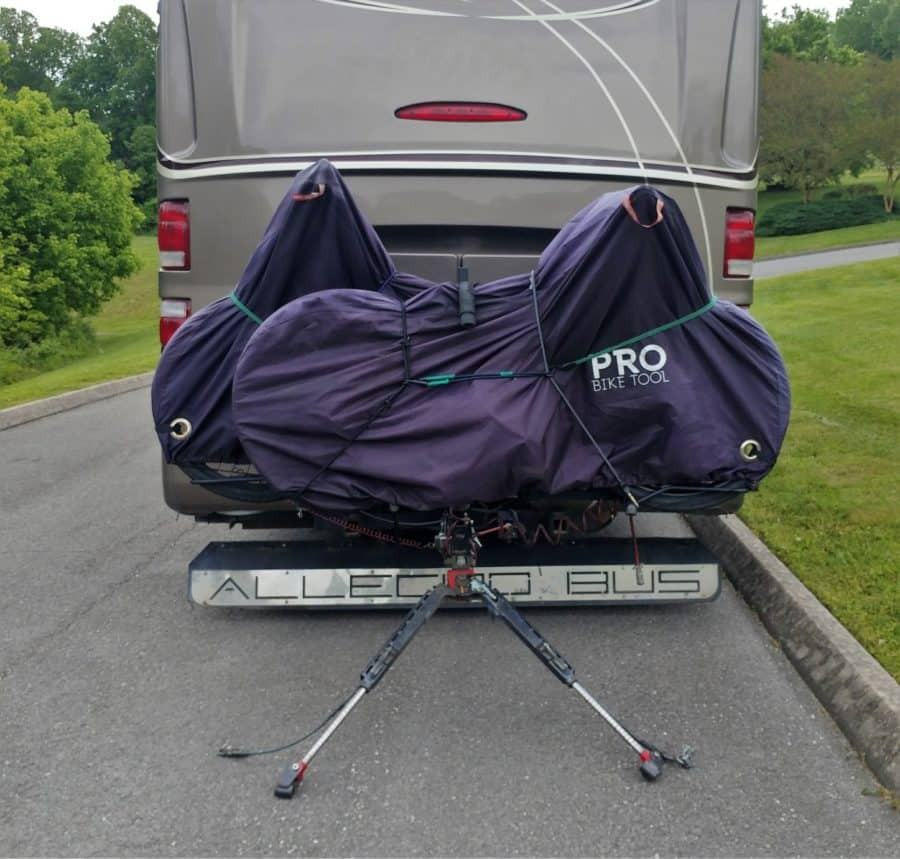 This is what our bike rack looks like just before we attach the car to the Roadmaster tow arms. In this picture, the bikes are ready to go.
This is what our bike rack looks like just before we attach the car to the Roadmaster tow arms. In this picture, the bikes are ready to go.
This “between-vehicles” approach requires careful consideration of hitch configuration, which I’ll discuss further.
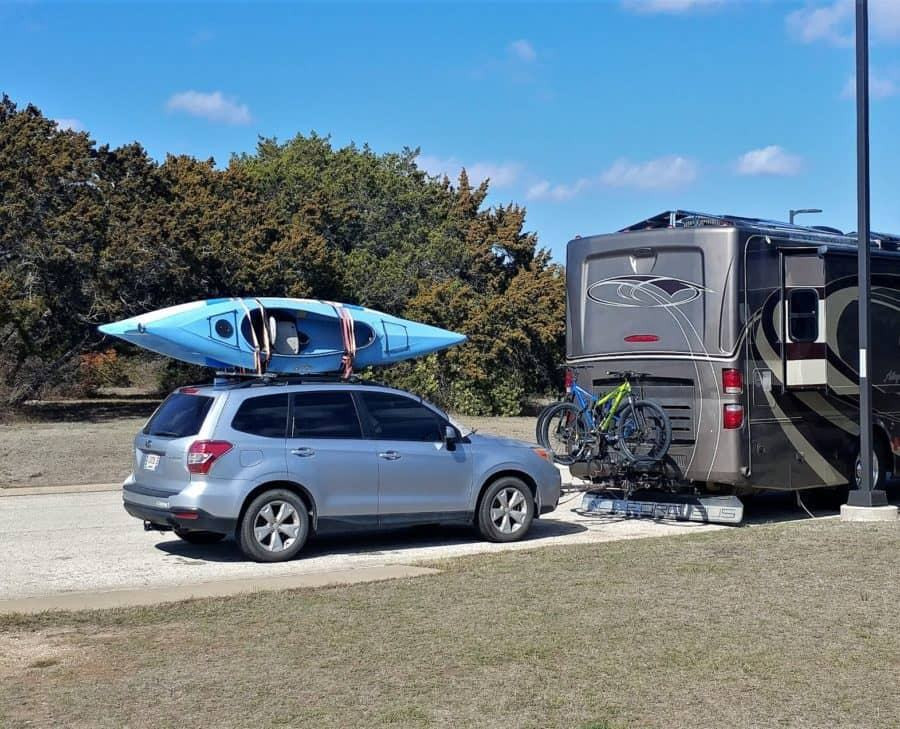 Here is a picture of the bikes on the rack between our RV and the car. (The last two pictures were of my old bike rack but this still illustrates the layout.)
Here is a picture of the bikes on the rack between our RV and the car. (The last two pictures were of my old bike rack but this still illustrates the layout.)
Installation Considerations: Hitch Compatibility
Initially, my installation of the Swagman RV-Approved Bike Rack wasn’t seamless. The issue wasn’t the rack itself, but rather a compatibility problem with my existing double hitch receiver. This highlights a crucial step: ensuring your hitch setup is suitable for your chosen travel trailer bike rack.
The Double Hitch Dilemma
For those towing a vehicle behind their travel trailer, a double hitch receiver is necessary to accommodate both the tow bar and the bike rack. My original double hitch receiver lacked sufficient vertical space between the upper and lower receivers. This became apparent when I tried to stow my Roadmaster tow arms with the new bike rack installed.
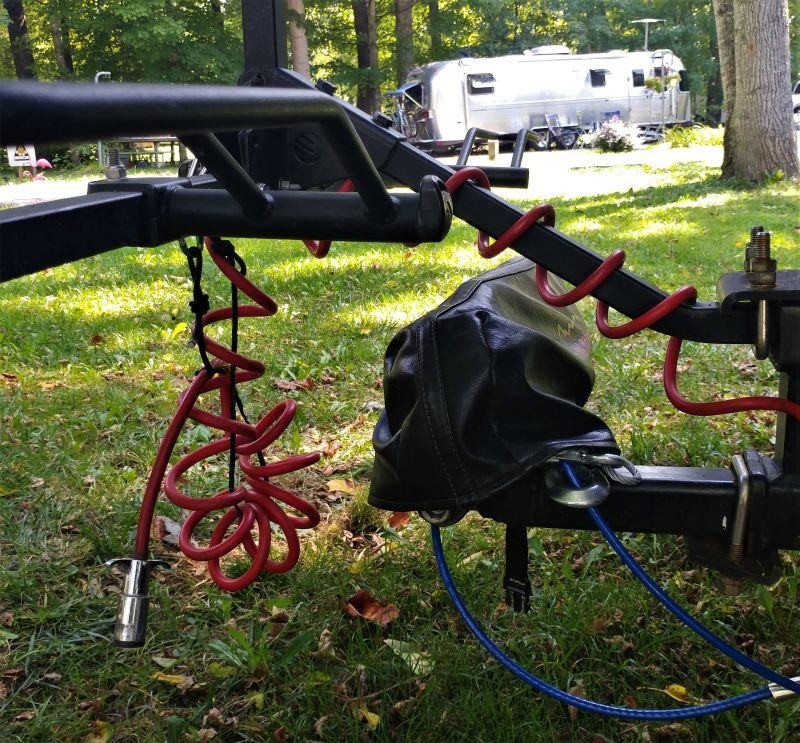 This is a picture of our old bike rack that is made out of 1 1/4 steel tubing.
This is a picture of our old bike rack that is made out of 1 1/4 steel tubing.
The old bike rack, with its bent tubing for extra clearance, had masked this issue. However, the robust Swagman rack revealed the problem. The solution? Upgrading to a taller double hitch receiver.
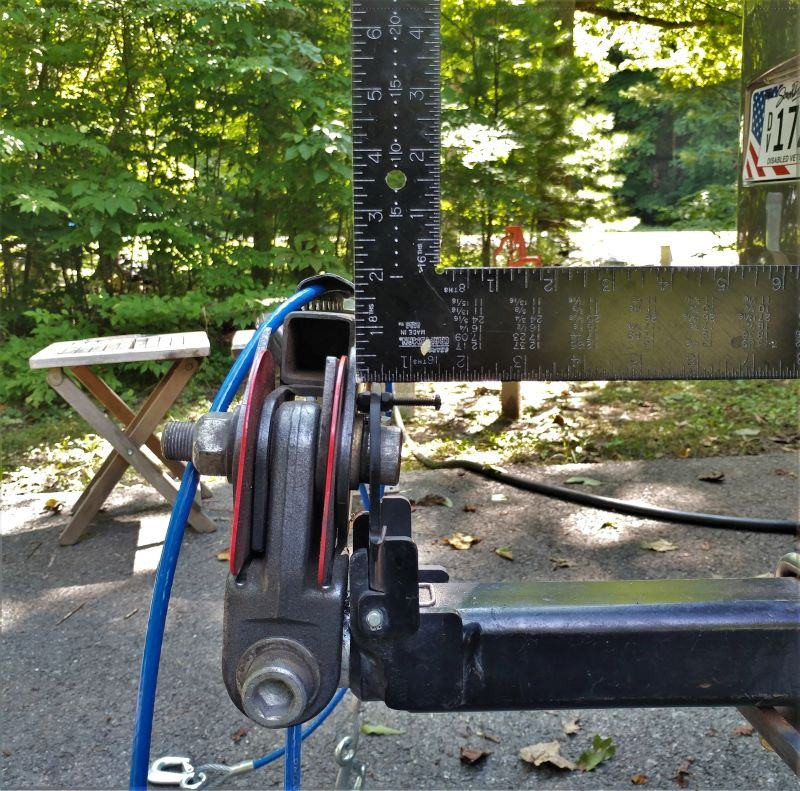 In this picture, the Roadmaster Falcon All Terrain Tow Bar is in the stowed position. The result was I had to buy a new taller double hitch to go with my new bike rack.
In this picture, the Roadmaster Falcon All Terrain Tow Bar is in the stowed position. The result was I had to buy a new taller double hitch to go with my new bike rack.
This new, taller receiver provided the necessary clearance for both the bike rack and stowed tow arms, resolving the compatibility issue and ensuring a secure and functional setup.
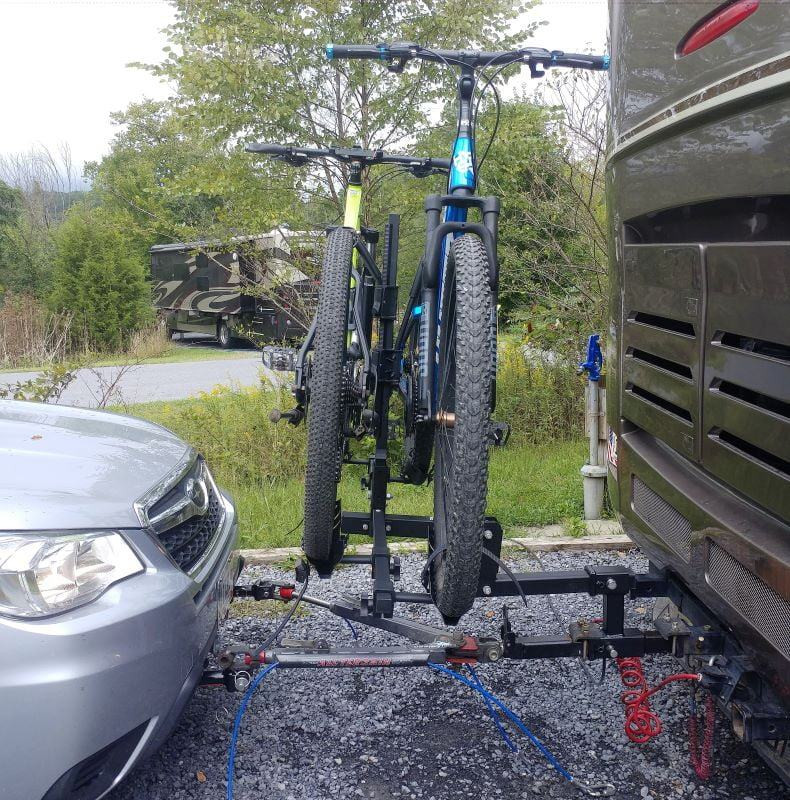 Here is my finished configuration with my taller double hitch receiver. It made all the difference in the world in terms of success.
Here is my finished configuration with my taller double hitch receiver. It made all the difference in the world in terms of success.
Key takeaway: Before installing your travel trailer bike rack, especially with a double hitch setup, carefully measure and ensure adequate clearance for all components.
Swagman RV-Approved Bike Rack Features: A Closer Look
Out of the box, the Swagman RV-Approved Bike Rack requires minimal assembly. The components are well-organized and straightforward to put together.
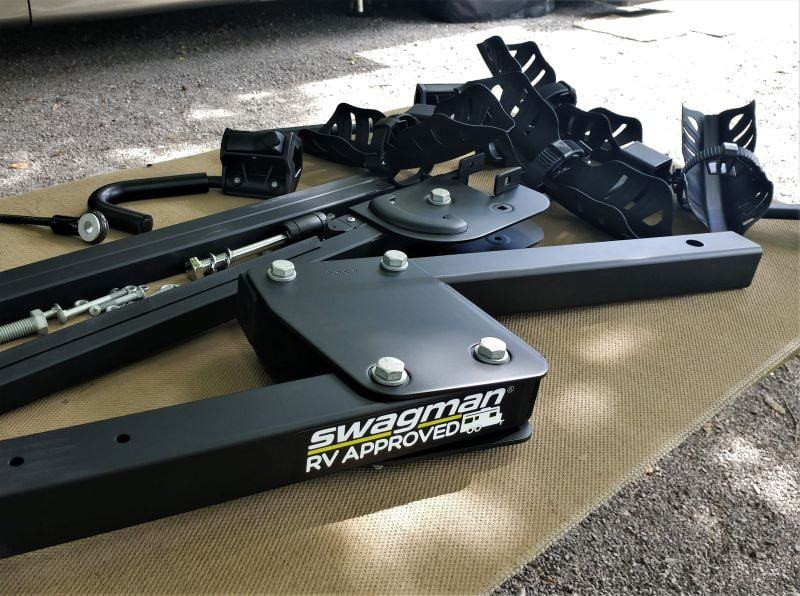 After removing the Swagman RV-Approved Bike Rack from the box I had to do a little pre-assembly In this picture the parts are all laid out with the packing plastic removed.
After removing the Swagman RV-Approved Bike Rack from the box I had to do a little pre-assembly In this picture the parts are all laid out with the packing plastic removed.
One notable feature is the self-securing connection to the hitch receiver. Unlike my previous rack, which required a separate U-bolt clamp to prevent wobbling, the Swagman rack utilizes a threaded hitch pin.
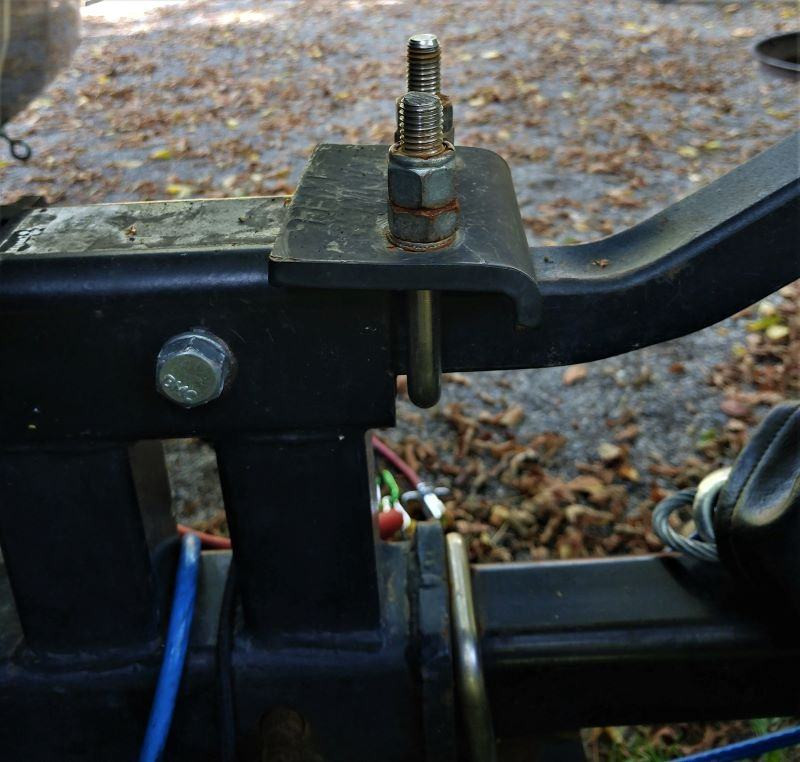 This plate and U bolt with these large nuts on the top prevent movement between the bike rack and the hitch receiver.
This plate and U bolt with these large nuts on the top prevent movement between the bike rack and the hitch receiver.
This “Locking Anti-Rattle Threaded Hitch Pin” effectively eliminates play and movement between the rack and receiver, contributing to a more stable and quieter ride. It also simplifies switching the rack between the RV and car, as no clamp needs to be removed.
Loading, Locking, and Weight Considerations
Loading bikes onto the Swagman rack is relatively easy, especially with lighter bikes. For heavier e-bikes, removing the battery and seat lightens the load. Swagman also offers a ramp accessory for easier loading of heavier bikes, which is worth considering if you have e-bikes or struggle with lifting.
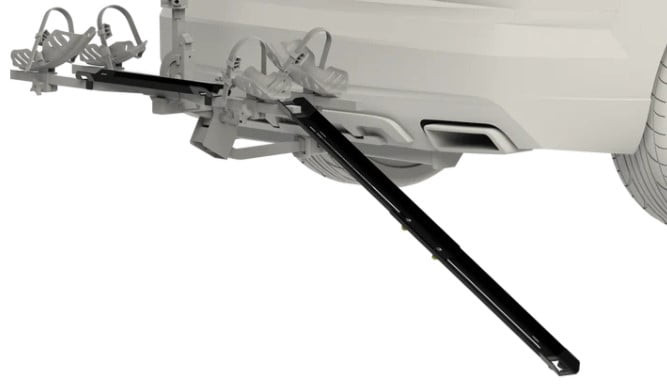 Swagman ramp
Swagman ramp
Security is also addressed with a built-in locking system. A cable lock integrated with the hitch pin secures both the bikes to the rack and the rack to the vehicle, offering a convenient, all-in-one security solution. For added security, I use supplementary locks and chains.
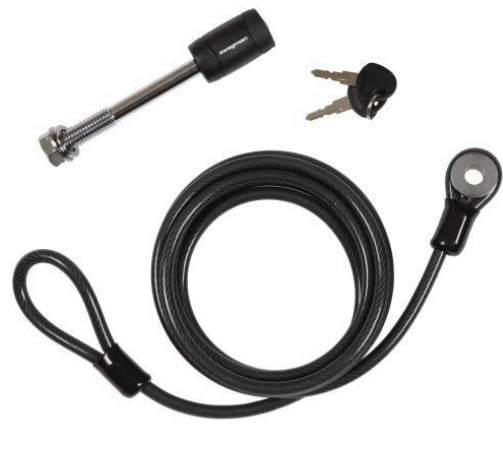 Swagman cable lock with hitch pin
Swagman cable lock with hitch pin
While robust, the Swagman RV-Approved Bike Rack isn’t designed for unlimited weight. Testing with a heavy Pedego cargo e-bike revealed that a single, very heavy bike might approach the rack’s weight limit. It’s crucial to consider the weight rating of any travel trailer bike rack and ensure it’s appropriate for your bikes.
 Pedego cargo e-bike installed on the back of our car. I don
Pedego cargo e-bike installed on the back of our car. I don
A Guide to Choosing the Best Travel Trailer Bike Rack
Selecting the right travel trailer bike rack involves several key considerations. Here’s a comprehensive guide to help you make the best choice:
RV Type Matters: Motorized vs. Towable
Installation is generally simpler on motorized RVs compared to towable trailers. Motorized RVs often have pre-installed two-inch receivers, simplifying bike rack attachment. Towable RV frames, however, may require additional receiver installation, which can be more complex.
Bumper Beware: Never Attach to Trailer Bumpers
Crucially, never attach a bike rack to a travel trailer bumper. Bumpers are not engineered to withstand the dynamic loads exerted by bike racks and bikes during travel. This is a common mistake that leads to rack failure and potential bike loss.
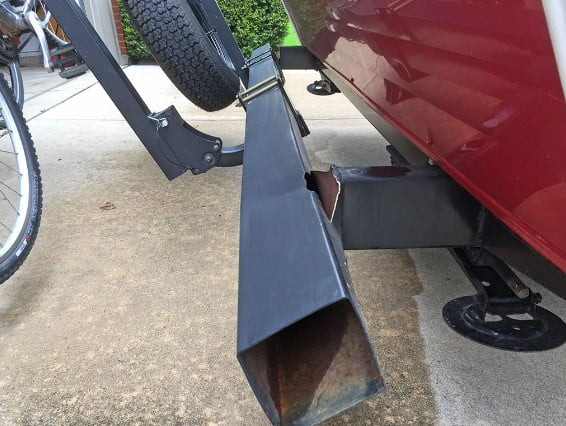 Bike rack attached to a trailer bumper.
Bike rack attached to a trailer bumper.
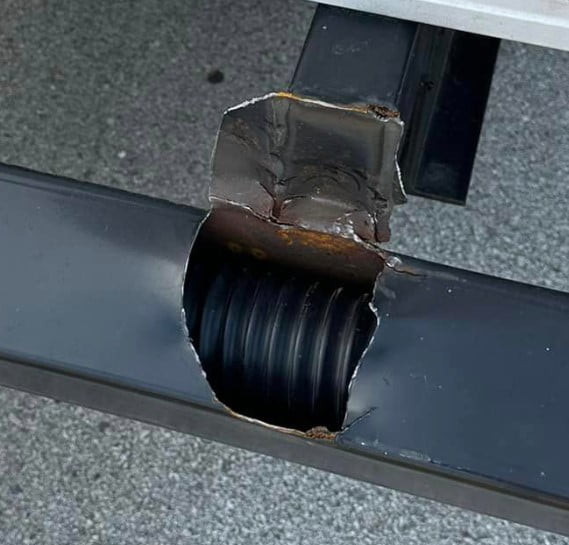 Trailer bumpers can hold a sewer hose and nothing else.
Trailer bumpers can hold a sewer hose and nothing else.
Suspension and Stability
Towable RVs often lack shock absorbers, relying solely on springs. This can contribute to increased instability and stress on bike racks. Motorized RVs, especially those with air-ride suspension, offer a smoother ride, reducing dynamic loads on the rack.
Essential Bike Rack Features to Consider:
- RV-Approved Rating: Prioritize bike racks specifically labeled “RV-Approved.” This indicates the manufacturer stands behind the product for RV use, considering the unique stresses involved.
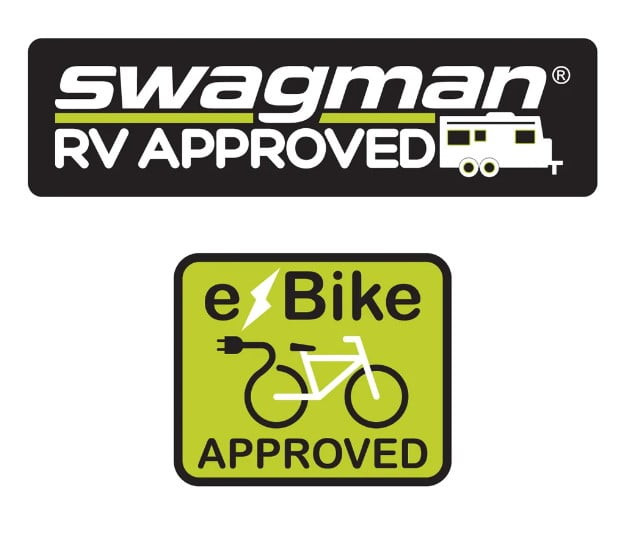 Swagman RV-approved bike rack
Swagman RV-approved bike rack
- Stinger/Receiver Bar Length and Strength: Ensure the stinger (the part that inserts into the hitch receiver) is long and strong enough to safely extend beyond the RV, especially if using a dual hitch. Avoid excessive extension, as it increases leverage and stress.
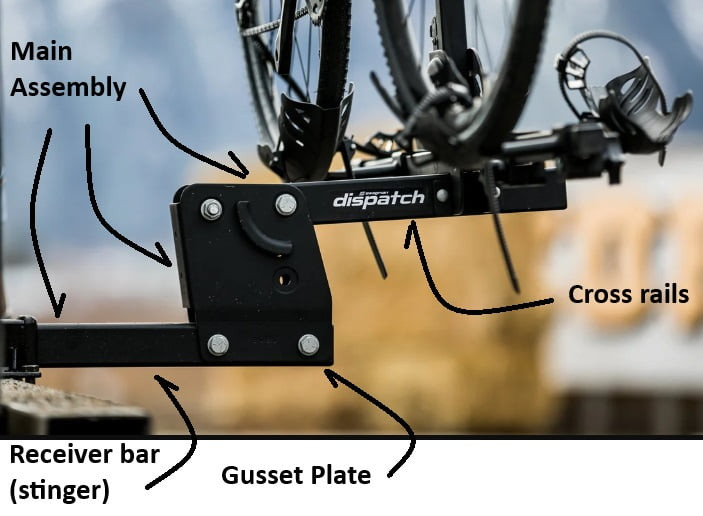 Swagman Bike Rack Components
Swagman Bike Rack Components
-
Clearance: Check for sufficient ground clearance to prevent dragging, especially when driving over uneven terrain or dips. Also, ensure the bike rack and bikes don’t interfere with your tow vehicle, if applicable.
-
Avoid Hinged Racks: Opt for non-folding, non-hinged racks for maximum strength and durability. Hinges introduce potential weak points.
-
Platform vs. Hanging Racks: Choose platform racks over hanging racks, especially for e-bikes or heavier bikes. Platform racks support bikes by the wheels, offering greater stability and preventing sway. Hanging racks can also be unsuitable for step-through bike frames.
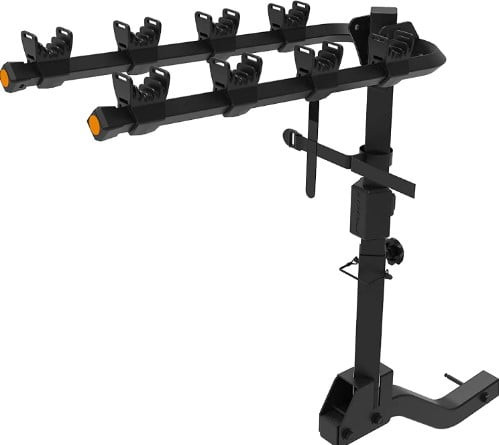 Bikes hang on the top tube from this rack.
Bikes hang on the top tube from this rack.
-
Non-Contact or Fender-Friendly Designs: Consider non-contact bike racks that secure bikes by the wheels only, avoiding frame contact, which is ideal for carbon frames. If your bikes have fenders, look for racks designed to accommodate them.
-
E-bike Rating: If you have or plan to get e-bikes, choose a travel trailer bike rack specifically rated for e-bike weights.
-
Loading Ramp Compatibility: For ease of loading, especially with heavier bikes, consider a rack compatible with a loading ramp accessory.
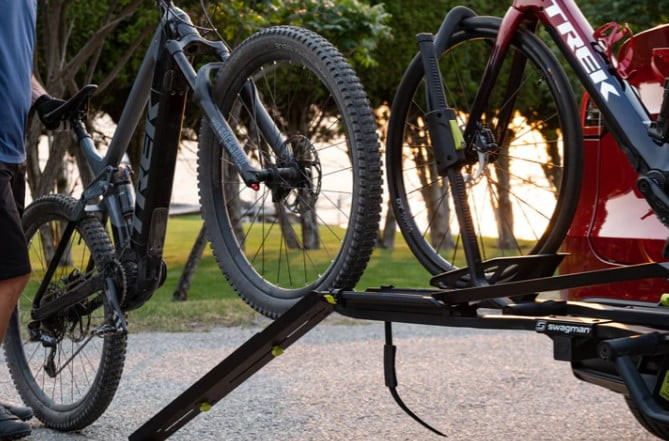 Loading a bike with a Swagman Bike ramp.
Loading a bike with a Swagman Bike ramp.
Recommended Products and Links
Here are links to products mentioned in this article and other recommended options for your travel trailer bike rack setup:
Hitch Receivers and Adapters:
- Two-inch Hitch Receiver (for car): e-trailer Trailer Hitch Receiver 2″ for a Subaru Forester (or search for your vehicle model)
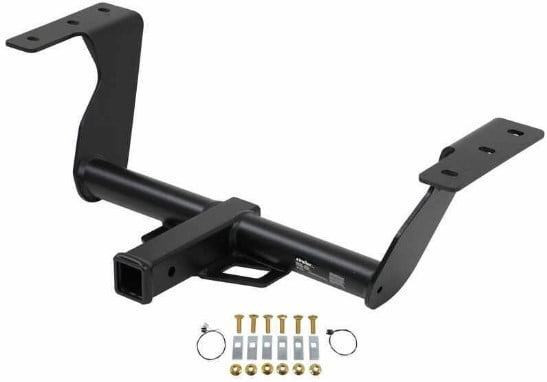 e-trailer Trailer Hitch Receiver
e-trailer Trailer Hitch Receiver
- Dual Hitch Receiver: Roadmaster dual hitch receiver 10″ Drop/Rise
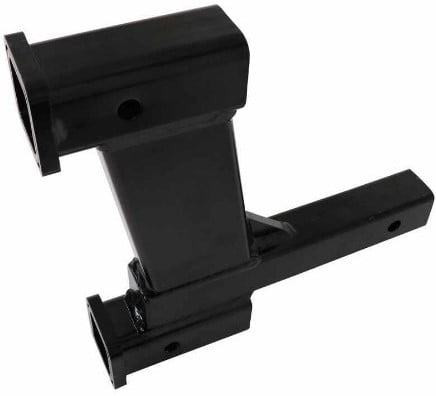 Roadmaster Dual Hitch Receiver Adapter
Roadmaster Dual Hitch Receiver Adapter
Tow Bar:
- Roadmaster Falcon All Terrain Tow Bar: Roadmaster Falcon All Terrain Tow Bar
Swagman RV-Approved Bike Racks:
- Swagman RV-approved bike rack “Dispatch” model (for standard bikes): Swagman RV-approved bike rack “Dispatch” model.
 Swagman Dispatch Bike Rack
Swagman Dispatch Bike Rack
- Swagman RV-approved bike rack “E-Spec” model (for e-bikes): Swagman RV-approved bike rack “E-Spec” model.
 Swagman E-Spec Bike Rack for 2 Electric Bikes
Swagman E-Spec Bike Rack for 2 Electric Bikes
- Swagman RV-Approved Bike Rack “Escapee” model (non-frame contact): Swagman RV-approved bike rack “Escapee” model
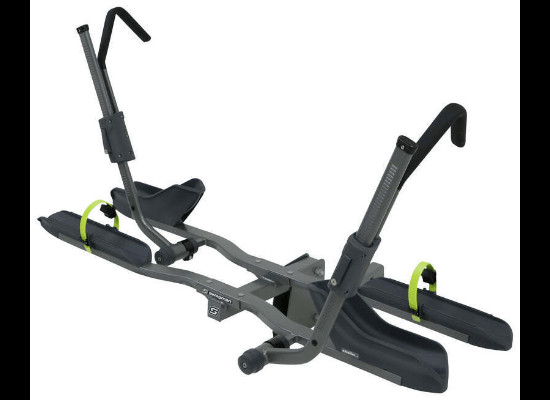 Swagman Escapee Bike Rack
Swagman Escapee Bike Rack
-
Swagman Ramp (loading ramp accessory): Swagman Ramp
-
Swagman RV-Approved bike rack “Traveler XC2” model: Swagman RV-Approved bike rack “Traveler XC2” model
-
Swagman RV-Approved bike rack “Nomad” model: Swagman RV-Approved bike rack “Nomad” model
Additional Resources:
- Original Do It Yourself RV Article: RV Life, Do-It-Yourself-RV-Bike-Rack
- Towing Setup Guide: How to tow – what we tow
Conclusion: Invest in a Reliable Travel Trailer Bike Rack
Even if you don’t own a travel trailer, the robustness of RV-approved bike racks like the Swagman models makes them an excellent choice for any vehicle. The peace of mind knowing your bikes are securely transported is invaluable. Don’t compromise on quality when it comes to protecting your bikes during travel.
Choosing the right travel trailer bike rack is an investment in your cycling adventures. By considering the factors outlined in this guide and opting for a reputable RV-approved model, you can ensure safe and enjoyable bike transport for years to come.
